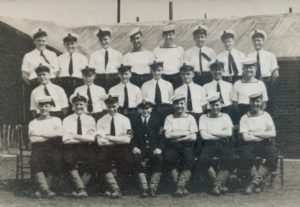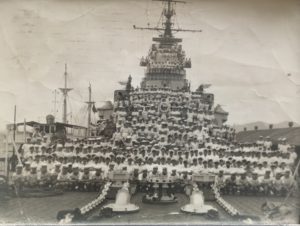Face to face with the horrors of war as a young man in the Royal Docks
My father Bill Grainger passed away in hospital earlier this summer at the age of 94 – and his funeral was held after a six week delay.
Just a few days after his funeral I listened to a cassette recording of him, found by his wife Hazel. He was being interviewed by a schoolgirl around 20 years ago. And she uncovered something I never knew.
How, as a young man he had faced the horrors of war on the dockside in the Royal Docks.
I knew of his love of the sea, sparked by seeing the Mauretania in the Royal Docks at the age of 12, his national service in The Navy and work life . I knew, like millions of other people, he had lived through the Second World War and The Blitz and wondered every day if he would survive.
I’ve listened to the cassette tape, which is very poor quality, to hear him tell the story in his own words.
He said: “In 1941, I got a job on the Woolwich Ferry as a deck boy. Although, more exciting times were to come. I then went to work on the Sun Tugs,” said Bill. “This part of my life has given me many memories, both good and bad. Working on the river as a young boy was fantastic. ”
- Bill Grainger
He then recalled the day, aged 16, that he saw something he would never forget. His memory may have made him recall things slightly differently. But I’ve spent the last two months digging up the exact details with the help of experts. But first, my dad’s version.
“One evening we were all told to get to work early on the Sun Tugs the next morning. It’s an incident that I remember very clearly in my mind that moved and touched me.
“We had to meet a destroyer at the Thames Estuary that had been badly damaged. We were to take over from the deep-sea tugs. The Thames Estuary was cleared for us so that we could get to the Royal Docks as quickly as possible.
“At the time, I didn’t know all of the circumstances, but soon after, we were told how important it was that we got the destroyer to the Docks. There were young sailors trapped in there. The ship had hit a mine causing the ship to spring a leak, and it was right down at the bow. Bulkheads are upright partitions that are used in case of an emergency surrounding fire or leakage, to stop it from spreading. The bulkheads on this ship had been used to stop the ship flooding. However, there were servicemen trapped inside where the water was coming in. It was thought that if we were quick enough getting the vessel into the dry dock that we might have saved some of them, but it was no good. They had drowned. When we got back to the dock, the scenes there were of tragedy, ” said Bill.
“Coffins lay on the dockside, with the White Ensign draped over them. The bodies were then transferred into the coffins. It was a sight I will never forget.”
But time was of the essence for the War effort and Bill said the moment the bodies of the young men were removed, the dry dock was filled up so that the destroyer could be taken back to Chatham or another shipyard to get her ready for repair, to get back into action.
All I know about the young girl who conducted the interview is that she is now a doctor. But my family and I are grateful to her for giving us a piece of our dad’s history.
* My dad Bill in his Navy training days
Over the last few months, with the considerable help of the Royal Navy at Chatham Historic Dockyard Trust I have discovered the ship was the HMS Stevenstone.
- HMS Stevenstone. Picture Navy Photos Mark Teadham
Exhibitions Officer Jasmine Godmon said she was hit by a mine during a patrol in 1944.
She said: “The Destroyer sustained major damage to the bow, causing flooding and fires. It was escorted by Euston Cross (deep sea tug) and a salvage vessel into the Thames Estuary. It was later transferred to Sheerness Dockyard for repairs. ”
The researchers then found the official report into the incident which makes chilling reading. It was written by The Royal Naval Serivice Surgeon Captain JLS Coulter DSC Rn Barrister at Law.
It reads:
HMS STEVENSTONE
“HMS Stevenstone was on patrol off Flushing on the evening of November 30 1944. At 1822 hours she was struck by an enemy mine. When the Stevenstone was struck, the ship seemed momentarily to lift out of the water, after which she started to settle by the bow. “The explosion had occurred in the forward half of the ship and immediate investigation showed that the main effects had been felt under the stokers’ messdeck.
The whole fore part of the ship was at once filled with fumes of oil and cordite, but, fortunately, the lights continued to function so that it was possible quickly to appreciate the extent of the damage. The after part of the messdeck concerned was found to be full of casualties numbering about 30. Some of these men were in considerable pain, were foaming at the mouth and finding great difficulty in breathing. Others appeared to be deeply unconscious and seemed partially asphyxiated.
“As fast as possible the accessible casualties were removed and placed on the upper deck. Owing to the presence of noxious fumes of some kind removal of these men was difficult. It was not possible to stay down in the messdeck for more than a few seconds without being overcome by these fumes. The Medical Officer and several rescuers attempted to remain longer on the messdeck, but they were themselves quickly rendered unconscious in the process. When there was no further sign of life on the messdeck, which was already flooding, and when the water level had risen to near the hatch, the order was given to batten down the hatch, thereby isolating the affected messdeck from the rest of the ship.
“A muster of the ship’s company now showed that 14 men were missing and 18 incapacitated. As regards the latter, the ship’s Medical Officer recorded:
‘Several stokers coming out of the flooding messdeck fell unconscious at the top of the hatch. I arranged for casualties to be moved into the fresh air, and many of those who had been brought out unconscious soon began to recover. Those who were physically wounded had only suffered superficially. The unconscious state of these men had obviously been caused by fumes of some kind. After an hour all but 18 men had recovered sufficiently to be able to carry on by themselves. Among the 18 remaining, 3 men became very violent while recovering consciousness and had to be given morphine in order to restrain them. In all these men the clinical picture was roughly as follows:
- When first seen the patient was deeply unconscious and ashen grey in appearance. All reflexes were absent. The pulse was thin and rapid and the rate 120. Respirations were very shallow and at a rate of 40.
- After 15 minutes the respirations had returned to normal, the pulse was stronger and had fallen to 90. The general condition had improved and colour was returning. The man could be roused, albeit with difficulty.
- After 30 minutes there was some mental confusion, complete disorientation, and active resistance to any physical interference.
- After 1 hour the mental state seemed normal and the man could easily be roused. But headache and vomiting were severe, and were followed by deep natural sleep.
- After 24 hours there seemed to be no after effects.’
The Medical Officer rightly considered that the general picture presented by these unconscious men was similar to any case of surgical anaesthesia carried to a deep level. His conclusion was that these men had been poisoned by fumes of methyl chloride, the source of which was probably damage to the ship’s refrigeration system. When first reported, his conclusions were doubted by some authorities, mainly, it would seem, on two grounds:
- The fact that no post mortem examination was ever conducted on seven bodies later recovered from the affected messdeck, and
- Absence of that lachrymation which, it was considered, would certainly have been present had the poisoning been due to fumes of methyl chloride.
However, quite apart from the view of the Medical Officer, the opinion of the Stevenstone’s Commanding Officer was quite definite in his official report of the incident in which he stated:
‘Undoubtedly some of the deaths occurred through men becoming unconscious on the messdeck through the escape of methyl chloride gas from the ship’s damaged refrigerator plant. One or two breaths were probably sufficient to render these men unconscious, after which they were drowned by the inrush of sea water. All who managed to get to the top of the hatch did so as they were about to be overcome by the gas. A few others were rescued, while unconscious, just before they would have been drowned by the rising water.’
In a later paragraph of his report the Commanding Officer gives the following most interesting account of the fortunate survival and escape of a stoker who was left behind on the messdeck while unconscious:
‘About two hours after the distorted hatch to the messdeck had been closed, shouting was heard. It seemed that one of those overcome by gas had survived. The clips of the hatch were eased back to test for water pressure and then the hatch was lifted. A stoker was found standing at the top of the ladder under the hatch with his head and shoulders just above the level of the water.
‘He could give little explanation about what had happened, except that at the time of the explosion he was sitting on a table at the forward end of the messdeck. He would seem at once to have been gassed, after which he must have fallen back unconscious on the messdeck table. The table itself was wrenched from its fittings by the explosion. With the unconscious stoker upon it it must have floated to the small space between the water and the deckhead above, where it remained. As the fumes cleared the unconscious stoker recovered and he was eventually awakened by the noise of hammering by damage control parties overhead. He then found himself under the hatch and started to shout.’
The ship was taken into the Royal Albert Dock and was then taken to Sheerness for repairs.
This account of the mining of HMS Stevenstone may best be concluded by an official report made to the Admiralty on January 18, 1945 which reads:
‘HMS Stevenstone has now entered dry dock. On examination of the ship’s refrigeration compartment it was found that the bulkhead was split, and that the pipes containing methyl chloride were fractured. This would have resulted in the damaged messdeck becoming filled with this gas.’ ”
For the Trust to have taken the time to find out this about an event that clearly shaped my dad’s life is wonderful. I will be always be grateful.
My dad spoke about many things concerning the War, how he was schooled once a week at home, and the dangers of the bombs that fell and other fears they faced. Elsewhere on my website is the story of the biggest ship to enter the docks and how it sparked his love of the sea.
At the end of this interview with the young girl my dad added another memory of life on the river .
* My dad Bill and his crewmates on board the HMS Sheffield
“Another event that I remember unmistakably in my mind is of the time we were ravenous and desperate. Working a 72-hour week for little money, we were often hungry.
“One time when on the tugs we were ordered to tow an American ship to the River Crouch, we saw a perfect opportunity to get some food. The lifeboats trailing along behind it were laden with tins.
“We had never seen so much food before, so we took some from the lifeboats. Boy did we have a feast among us that night. At that time, everyone was out for themselves. Due to rationing we were frequently hungry, so any time we could get hold of food we would jump at the chance. ”
Much of the food was taken home to his family.
Thanks for the memories dad.
Pictures: Royal navy Photos Mark Teadham and Colin Grainger





